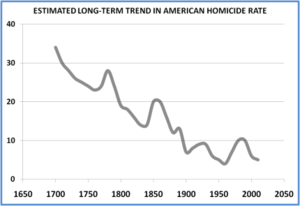CrimeThe real reason for a decline in violent crime
A scientific analysis of twenty million words recorded during 150 years of criminal trials at London’s Old Bailey reveals how changes in culture rather than law helped to reduce violent crime, according to a new study. “What we have been able demonstrate through analyzing the language used in court is that the decline in less serious forms of violence, such as assault, was not led by legislation or moments of dramatic change in the law, but by social attitudes,” says one of the authors.

Long term trend in homicide // Source: berkeley.edu
A scientific analysis of twenty million words recorded during 150 years of criminal trials at London’s Old Bailey reveals how changes in culture rather than law helped to reduce violent crime, according to a co-authored University of Sussex study.
Researchers applied a statistical formula based on the frequency of certain words, as categorized in Roget’s Thesaurus, to a digitized version of the court’s records, The Proceedings of the Old Bailey, between 1760 and 1913.
A University of Sussex release reports that the results showed that before the 1800s there was little distinction in the language used for violent and non-violent crimes — and the punishments were likely to be as severe for “theft” as for “assault.” By the 1840s, however, this had begun to change and crimes that involved “wounding” victims received more severe punishments.
Sussex historian Professor Tim Hitchcock, director of the Old Bailey Online project and co-author of the paper published in Proceedings of the National Academy of Sciences, says: “Historians have recognized that levels of violence, throughout Europe and North America plummeted during the 19th Century. Murder became a rarity.
“Scholars using traditional historical methodologies have ascribed this to the ‘civilizing process’ of society, led by the emergence of the modern Western state and its bureaucracies. The state became important in the control of cultures that encouraged violence, and in the direct policing and control of violence itself.
“What we have been able demonstrate through analyzing the language used in court is that the decline in less serious forms of violence, such as assault, was not led by legislation or moments of dramatic change in the law, but by social attitudes.”
Other developments, such the increasing use of lawyers, particularly those coached in how to present a crime to a jury, and the use of doctors as expert witnesses in trials for murder and assault, also brought new language and terminology into court records.
The release notes that Hitchcock, who has several other analyses planned for the Old Bailey digital archive, including a comparison of jurors’ backgrounds with the outcomes of trials, says: “One of the most important features of our work is this new ability to statistically analyze language on a large scale. Historians can now use the same tools as scientists to further illuminate what we know — and don’t know - about the past. The key is in knowing which questions to ask.”
Since being digitized, The Proceedings of the Old Bailey have already inspired a BBC dramatization of some of the cases.
— Read more in Tim Hitchcock et al., “The civilizing process in London’s Old Bailey,” Proceedings of the National Academy of Sciences (16 June 2014) (doi: 10.1073/pnas.1405984111)
